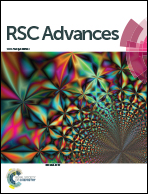Oxygen doped graphitic carbon nitride nanosheets for the degradation of organic pollutants by activating hydrogen peroxide in the presence of bicarbonate in the dark†
Abstract
The development of novel wastewater treatment processes that use heterogeneous catalysts to activate hydrogen peroxide (H2O2) with bicarbonate (HCO3−) has been a subject of great interest in recent years; however, significant challenges remain, despite research into numerous metal-based catalysts. The work presented herein employed oxygen-doped graphitic carbon nitride (O/g-C3N4) as a non-metal catalyst for activating H2O2 in the presence of HCO3−, and this method represented the first system capable of removing organic pollutants in the dark, to our knowledge. The catalysts were characterized using several microscopic imaging, spectroscopic, electrochemical, and crystallographic techniques, as well as N2-physorption procedures. Analysis of the results revealed that the O/g-C3N4 catalyst possessed a high specific surface area and many defect sites. Various operational parameters, including the relative amounts of HCO3−, H2O2, and O/g-C3N4, were systemically investigated. A clear performance enhancement was observed in the degradation of organic contaminants when subjected to the HCO3−–H2O2–O/g-C3N4 system, and this result was ascribed to the synchronous adsorption and chemical oxidation processes. The novel system presented herein represented a new water treatment technology that was effective for removing organic contaminants.



 Please wait while we load your content...
Please wait while we load your content...